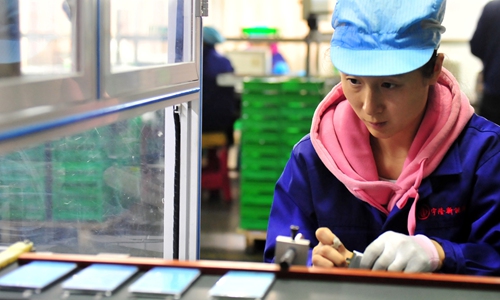HOME >> SOURCE
Chinese manufacturers eye broader automation to overcome labor shortage
By Yin Yeping Source:Global Times Published: 2020/2/18 19:27:10

A worker processes lithium battery in a new-energy vehicle factory in Yichang, Central China’s Hubei Province in December 2019. Photo: cnsphotos
While the COVID-19 epidemic outbreak might have caused layoffs nationwide, it also acted as a driving force for many Chinese manufacturer-clusters to plan future automation production lines to achieve smarter manufacturing.
Wei Jigang, a research fellow with the Development Research Center of the State Council, told the Global Times on Tuesday the outbreak will prompt manufacturing enterprises to accelerate the development of automation because it can reduce labor costs.
A source close to smartphone maker Vivo, told the Global Times on Tuesday that their production of mobile phone’s motherboards can achieve up to 80 percent automation now.
“The production is largely automated, but requires a small number of employees to keep an eye on the line,” he said, adding that they have now partially resumed production.
Xiaomi’s CEO Lei Jun said the first phase of Xiaomi's experimental mobile phone factory in Beijing is complete with a "very high degree of automation", reported the business information platform Chinastarmarket.cn on Friday.
A customer service representative of Xiaomi also confirmed with the Global Times on Tuesday, without revealing if the epidemic outbreak resulted in the launch of the automated factory.
Global market research institution, Trend Force, published a report on Friday, claiming some large companies’ supply chains remain unaffected by the outbreak since most semiconductor factories are highly automated.
Deng Ziwei, deputy general manager of CEC Industrial Internet, told the Global Times on Tuesday they are planning to use robotic tools to cover a shortage of workers now.
“While about half of our factory’s workers have returned to work, those in other areas, including Hubei Province, have been unable to do so,” Deng said.
According to Deng, the current robotic mobilization makes up 50 percent of the total capacity, and due to the shortage of workers, they are reinforcing further automation that is expected to make up for 30 percent of the total labor shortages.
China is moving towards industrial automation, which may not be achievable in the short term but the country is definitely making progress, Wei said.
“Companies need to build resilient supply chains wherein automation and digitization consist of important elements” Wei said.
Compared with large companies, some smaller ones appeared more vulnerable during the transformation process of the production model.
Liu Jialong, President of Shenzhen Elite Electronics, a medium-size power battery producer in Guangdong Province, told the Global Times only half of their production lines are automated.
“We should be able to resume work tomorrow (February 19), but we can't resume production, because all the employees are stuck in their hometown and cannot return,” he said.
Liu said the outbreak is accelerating their push toward broader automation.
The Ministry of Industry and Information Technology released a document on February 9, assuring effective measures to support enterprises' digital transformation, and help improve the level of intelligent manufacturing, to aid small and medium-sized enterprises’ work resumption in an orderly manner and tide over the difficulties.
Posted in: INDUSTRIES